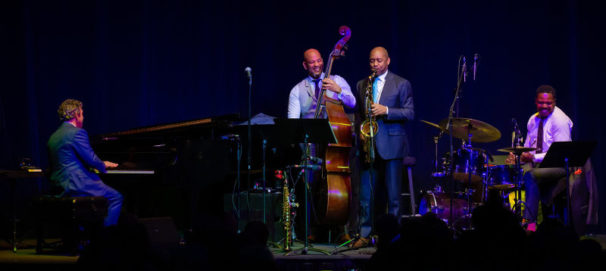
ed. note: This story by jazz writer Kirk Silsbee was commissioned and originally published by the Younes & Soraya Nazarian Center for the Arts. Excerpted with permission.
The timeless swing of the Count Basie Orchestra, the pure vocals of Lizz Wright, and the vibrant interplay of the Branford Marsalis Quartet represent three of the most important musical dialects in today’s national jazz conversation. With these quality offerings in the new fall season (Branford Marsalis Quartet on Thursday, October 28, and the Basie Band’s “Music of Ella Fitzgerald” featuring Lizz Wright on Wednesday, Nov. 17), The Soraya puts its chips on jazz, and lets it ride.

In 2019, the Branford Marsalis Quartet played onstage in the intimate Jazz Club setting and quickly became a Soraya favorite. Quite simply, it’s one of the great working jazz bands of our time. Begun in 1986, it has remained intact, with minor personnel changes. Along with the tenor and soprano saxophones of Marsalis, the group boasts pianist Joey Calderazzo, bassist Eric Revis, and drummer Justin Faulkner. Highwire interplay is a hallmark of the band, which redesigns standard material to its own ends. Don’t look for sixteen-chorus solos from this unit. “We don’t elevate improvisation over everything else in the music,” Marsalis says, speaking by cellphone on the road. “That’s like engaging in musical small talk all night long. We’re more interested in form and engagement.”
Marsalis contributes the bulk of the challenging material, like his haunting “Life Floating Through the Water Flowers.” But other pieces—like the intense “Dance of the Evil Toys” by Revis, and Calderazzo’s exotic Cianna”—come from within the band. Adding occasional well-chosen gems, like “Snake Hip Waltz” by the fascinating jazz composer Andrew Hill (1931-2007), give the Quartet one of the most potent books in contemporary jazz.
Marsalis’s musical scope isn’t limited to jazz. He’s a well-studied composer with a firm grounding in European concert music and opera. His study allows him to take on soundtrack and scoring projects like “Ma Rainey’s Black Bottom” (2020), and the recent “Tulsa Burning: The 1921 Race Massacre” special on the History Channel. (His score has earned a Grammy nomination.) That musical passion surfaces in the Quartet as well: the Marsalis tenor saxophone has grown into a majestic sound, capable of an array of colors and timbres. Nothing less than operatic richness comes from that horn.
The COVID-19 shutdown was especially hard on SoCal jazz venues. As performing spots closed, the quarantine also interrupted The Soraya’s ascendance as an important jazz destination. The promise of the upcoming Spring Jazz Festival (mainstage concerts with Wynton Marsalis and the Lincoln Center Jazz Orchestra and Gregory Porter; and Jazz Club concerts with Gerald Clayton, Gretchen Parlato and Harold Lopez-Nussa) signals that The Soraya is swinging again in full force.
Author Kirk Silsbee publishes promiscuously on jazz and culture.
An Evening with Branford Marsalis | The Soraya | Thurs Oct 28
ed. note: the Marsalis Quartet is also playing in the region at Long Beach’s Carpenter Center, Saturday Nov 6
